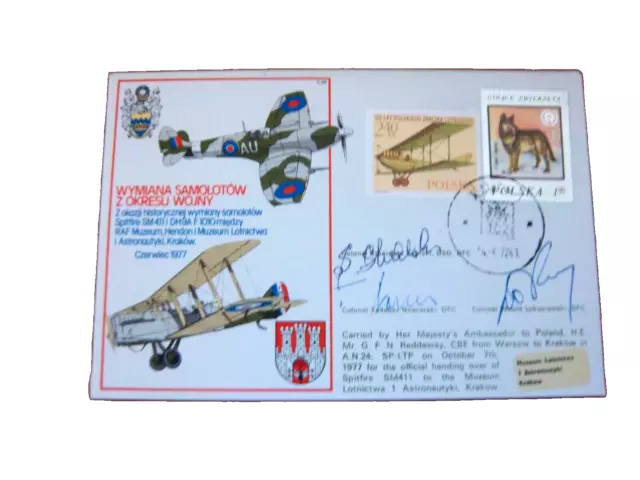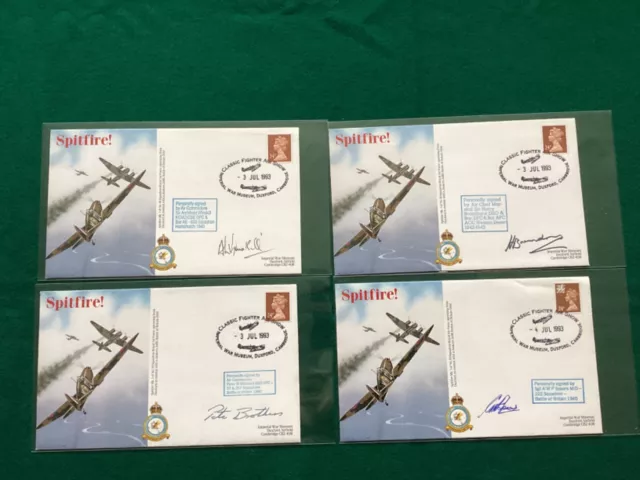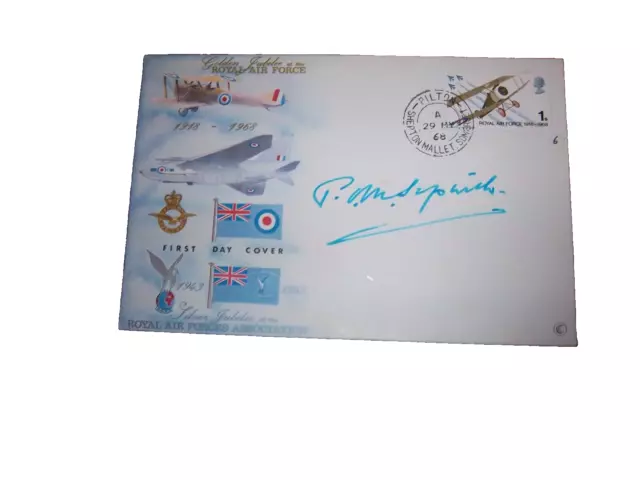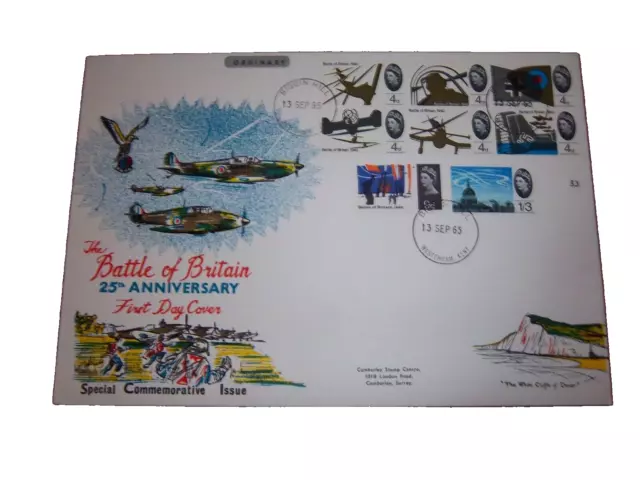UNIQUE - 1965 BATTLE OF BRITAIN 25th ANNIVERSARY MULTI SIGNED FIRST DAY COVER
Air Commodore Ronald Berry, CBE , DSO , DFC & Bar (3 May 1917 – September 2000) was a British flying ace and senior officer of the Royal Air Force (RAF) during the Second World War and the postwar period. During his service with the RAF, he was credited with shooting down at least fourteen aircraft with several more shared with other pilots.
Born in Kingston upon Hull , Berry joined the Royal Air Force Volunteer Reserve in 1937 and was called up for service in the RAF upon the outbreak of the Second World War. Posted to No. 603 Squadron , he flew extensively in the Battle of Britain during which he achieved a number of his aerial victories. For much of 1941 he served as a fighter controller at Turnhouse . Given command of No. 81 Squadron early the following year, he led it through the campaign in North Africa through late 1942 to early 1943, switching to leading No. 322 Wing in March. He returned to the United Kingdom and spent the remainder of the war in training and staff posts. Remaining in the RAF in the postwar period, he served in a variety of roles with Fighter Command , Bomber Command and the Air Ministry . He ended his military career in early 1969, having reached the rank of air commodore . He retired to Hornsea and died in September 2000, aged 83.
Signed by :: Group Captain Denys Gillam DFC*,DSODenys Edgar Gillam was born at Tynemouth on 18th November 1915 and educated at Bramcote, Scarborough and Wrekin College, Shropshire. He was awarded his 'A' Flying License at Public School Aviation Camp at Norwich on 12th September 1934.
He joined the RAF on a short service commission in February 1935 and was posted to 6 FTS Netheravon on 7th May. With his flying training completed he joined 29 Squadron at North Weald on 6th March 1936.
Gillam was posted to the Met Flight at Aldergrove on 25th January 1937. He was awarded the AFC (gazetted 9th June 1938) for flying food to Rathlin Island, which had been isolated by a gale for three weeks. He made two perilous landings in a Westland Wallace.
On 18th September 1939 Gillam was posted to 616 Squadron at Finningley. Over Dunkirk on 1st June 1940 he damaged a Ju88. Gillam claimed a Ju88 destroyed on 15th August, a Me109 on the 26th, a Me110 on the 29th, a Me109 destroyed, another probably destroyed and another two damaged on the 30th and another Me109 destroyed on the 31st.
On 1st September 1940 Gillam destroyed a Do17, probably another Do17 and a Me109 and damaged a third Do17 and on the 2nd he destroyed a Me110. In this last action his engine was set alight by a Me110 over the Maidstone area. Gillam baled out, unhurt. His Spitfire, X4181, crashed at Brook Farm, Capel.
Gillam was posted to 312 (Czech) Squadron at Speke on 6th September as a Flight Commander. He destroyed a Ju88 as he took off on 8th October, the squadron's first victory and probably the fastest confirmed victory of the war.
He was awarded the DFC (gazetted 12th November 1940).
In December 1940 Gillam took command of 306 (Polish) Squadron at Tern Hill. He was posted to HQ 9 Group on 2nd March 1941 and returned to operations in July as CO of 615 Squadron. He destroyed two He59's on the water on 9th October, was awarded a Bar to the DFC (gazetted 21st October 1941) and the DSO (gazetted 12th December 1941).
Gillam was shot down on 23rd November by ground fire at Dunkirk and baled out, wounded in legs and arms. He got into his dinghy and was protected by aircraft of 615 until an ASR launch arrived from the Goodwins and picked him up.
In January 1942 Gillam went to the USA to lecture American aircrews. Back in the UK in March, he was posted to Duxford to form the first Typhoon Wing, which made its first operational appearance at Dieppe on 19th August.
Gillam attended the RAF Staff College in October and was posted to HQ 12 Group in February 1943. He was sent to the Command and General Staff School, Fort Leavenworth, Kansas in August and after his return to the UK was appointed Wing Leader 146 Wing in December.
Gillam took Command of 20 Sector 2nd TAF in April 1944 and on 17th July he was given command of 146 Wing. He was awarded a Bar to the DSO (gazetted 11th August 1944).
On 24th October he led the Wing against a building in Dordrecht where a conference of high-ranking German officers was taking place. Gillam dived from 6,000 feet and dropped a marker bomb, followed by two 500lb. bombs. He was followed by five Typhoons which bombed from a very low level. Among the dead were two Generals, 17 senior officers and 55 other officers of the HQ of the German Fifteenth Army
Awarded a second Bar to the DSO (gazetted 23rd January 1945), Gillam was posted in February 1945 to HQ 84 Group as Group Captain Ops. In August he went to 84 Group Disbandment Centre and was released from the RAF in October 1945.
Signed by :: Air Vice Marshal David Malden DFC*,DSOFrancis David Stephen Scott-Malden was born on 26th December 1919 at Portslade, Sussex, the son of a school master at Windlesham House Preparatory School. He was educated at Winchester College as a Goddard Scholar and won the Ashburton Shield at Bisley before going on to Kings College, Cambridge where he read Classics and won the Sir William Browne Medal for Greek Verse in 1939.
He joined the University Air Squadron in November 1938 and transferred to the RAFVR on 14th June 1939 as an Airman u/t Pilot. Scott-Malden was called to full-time service and commissioned on 3rd October 1939.
On 1st January 1940 he was posted to RAF College FTS Cranwell and after completing his flying training he went to No. 1 School of Army Co-operation at Old Sarum for a course in late May 1940.
The course had hardly began when the chief instructor announced that he had 'a severe disappointment' to communicate:
'Gentlemen' he said 'you are to be transferred immediately to fighters'. Scott-Malden joined in 'the wild whoop as the classroom emptied, leaving the chief instructor standing alone beside the blackboard'.
On 10th June Scott-Malden arrived at 5 OTU Aston Down and after converting to Spitfires joined 611 Squadron at Digby on 23rd June.
He said at the time 'Twelve months before Dunkirk I was receiving Cambridge's Gold Medal for Greek Verse - an unusual qualification for a fighter pilot. A well trained mind is an asset, but in the skies of Britain in 1940 to be too academic was not a recipe for survival. I was lucky to come through. Many of my university friends did not'.
On 4th October 1940 he went to 603 Squadron at Hornchurch. He probably destroyed a Me109 on the 12th, damaged two CR42s on 23rd November and shared a Do17 on the 29th.
Scott-Malden became a Flight Commander in May 1941. On the 11th he took ‘A’ Flight to Drem for a night-flying course.
On the 28th he probably destroyed a Me109 and damaged another, on 7th, 14th, 21st June and 8th and 12th July he damaged Me109s, on 17th, 19th and 26th August he destroyed Me109s and on 18th September he probably destroyed another.
Scott-Malden was awarded the DFC (gazetted 19th August 1941) and in late September he was promoted and given command of 54 Squadron at Hornchurch.
On 4th November he damaged another Me109. In late November 1941 Scott-Malden was posted to HQ 14 Group Inverness on staff duties. He was appointed to lead the North Weald Norwegian Wing in March 1942.
He got a probable Fw190 on 28th April, damaged two Me109s on 4th May, probably destroyed a Fw190 on the 19th and damaged a Me109 on the 27th.
Scott-Malden was awarded a Bar to the DFC (gazetted 5th June 1942). On 19th and 29th June he shared in destroying Fw190s and on 19th August, over Dieppe, he damaged a Do217.
He was awarded the DSO (gazetted 11th September 1942) and the Norwegian War Cross (gazetted 6th October 1942). The latter was presented by King Haakon of Norway who then invited Scott-Malden to lunch at Claridges.
He was then posted away for a rest and then sent on a speaking tour of American universities. From July to October 1943 Scott-Malden was Liaison Officer with 8th Bomber Command USAF.
He commanded RAF Hornchurch, aged 23, from 28th October 1943 to 6th February 1944, when he was posted to a mobile GCU in 2nd TAF, preparing for the invasion of Europe. Initially they lived in tents on Goodwood racecourse.
After D-Day the unit moved to Normandy. In August 1944 Scott-Malden was promoted to Group Captain and took command of 126 Wing. He was posted to the Air Ministry in April 1945, to work on redeployment of Air Forces from Europe to the Far East.
- Condition: Used
- Condition: Minor corner faults - Signed by four Battle of Britain pilots
- Type: Military
- Signed: Yes
- Object: Signed Cards
- Country/Region of Manufacture: United Kingdom
- Certification: Certified: Private Signings
PicClick Insights - UNIQUE - 1965 BATTLE OF BRITAIN 25th ANNIVERSARY MULTI SIGNED FIRST DAY COVER PicClick Exclusive
- Popularity - 0 watchers, 0.0 new watchers per day, 16 days for sale on eBay. 0 sold, 1 available.
- Best Price -
- Seller - 11,204+ items sold. 0% negative feedback. Top-Rated Plus! Top-Rated Seller, 30-day return policy, ships in 1 business day with tracking.
People Also Loved PicClick Exclusive

UNIQUE 1965 BATTLE OF BRITAIN 25th ANNIVERSARY MULTI SIGNED FDC + SIGNED LETTER
£100.00 Buy It Now 13d 23h
Raf C48 Special Cover Signed By Three Polish Battle Of Britain Pilots
£30.00 10 Bids 4d 8h
Battle of Britain. Peter M Brothers Ace pilot and 3 other signed stamp covers
£25.00 Buy It Now 27d 4h
RARE - 1968 50th ANNIVERSARY OF THE RAF SIR TOM SOPWITH SIGNED COVER
£20.00 1 Bid 8h 8m
Rare Battle of Britain Signed G W Rouse DFC , H Stewart Battle of Britian Pilot
£69.95 Buy It Now 16d 8h 5 watchers
5 watchers1965 THE BATTLE OF BRITAIN 25th ANNIVERSARY FIRST DAY COVER BIGGIN HILL POSTMARK
£0.99 0 Bids 8h 0m
1965 25th anniversary of the battle of britain unmounted mint set of 8
£1.10 0 Bids or Buy It Now 6d 22h
BBC Production For Johnny 25th Anniversary Battle of Britain 12" Vinyl Record
£9.99 Buy It Now

